剑桥英语青少版第一单元导学案
- 格式:doc
- 大小:63.50 KB
- 文档页数:6
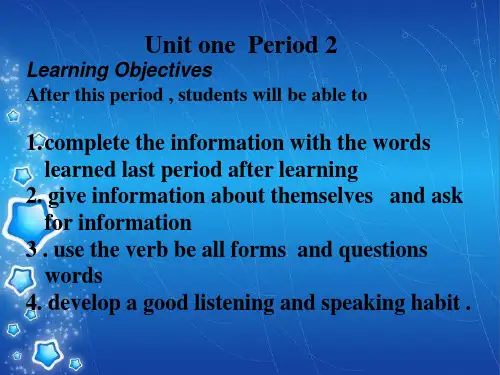
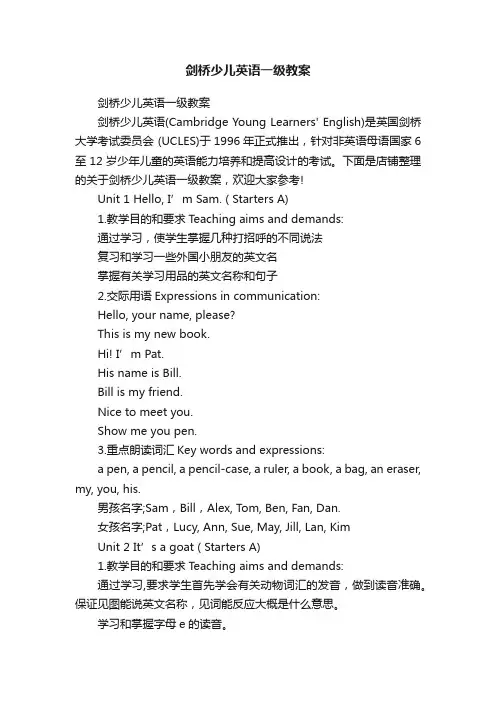
剑桥少儿英语一级教案剑桥少儿英语一级教案剑桥少儿英语(Cambridge Young Learners' English)是英国剑桥大学考试委员会 (UCLES)于1996年正式推出,针对非英语母语国家6至12岁少年儿童的英语能力培养和提高设计的考试。
下面是店铺整理的关于剑桥少儿英语一级教案,欢迎大家参考!Unit 1 Hello, I’m Sam. ( Starters A)1.教学目的和要求T eaching aims and demands:通过学习,使学生掌握几种打招呼的不同说法复习和学习一些外国小朋友的英文名掌握有关学习用品的英文名称和句子2.交际用语Expressions in communication:Hello, your name, please?This is my new book.Hi! I’m Pat.His name is Bill.Bill is my friend.Nice to meet you.Show me you pen.3.重点朗读词汇Key words and expressions:a pen, a pencil, a pencil-case, a ruler, a book, a bag, an eraser, my, you, his.男孩名字;Sam,Bill,Alex, Tom, Ben, Fan, Dan.女孩名字;Pat,Lucy, Ann, Sue, May, Jill, Lan, KimUnit 2 It’s a goat ( Starters A)1.教学目的和要求T eaching aims and demands:通过学习,要求学生首先学会有关动物词汇的发音,做到读音准确。
保证见图能说英文名称,见词能反应大概是什么意思。
学习和掌握字母e的读音。
能用句型进行简单的对话。
2.交际用语Expressions in communication:What’s this, Mr. Li?It’s a goat.It’s a long tail.Smile, please!This is my cat, I love it.3.重点朗读词汇Key words and expressions:a horse, a fish, a duck, a turtle, , a cow, a rabbit, a cat, a chicken, a dog, a sheep, a frog, a goat,Unit 3 I like apples ( Starters A)1.教学目的和要求T eaching aims and demands:通过学习,初步掌握水果名称的读音。
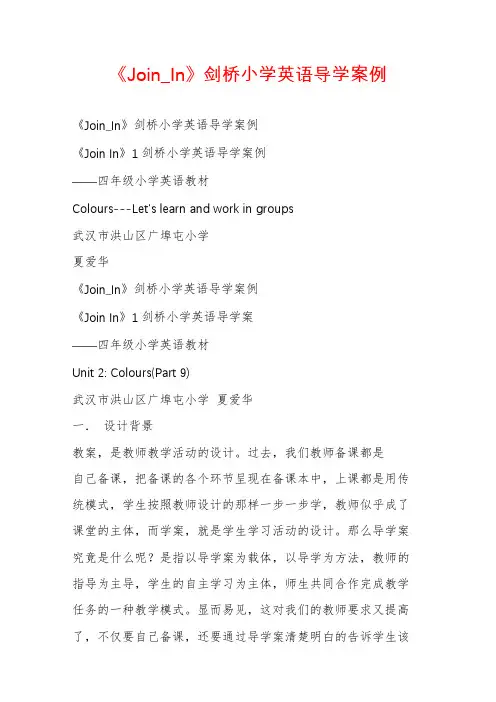
《Join_In》剑桥小学英语导学案例《Join_In》剑桥小学英语导学案例《Join In》1剑桥小学英语导学案例――四年级小学英语教材Colours---Let’s learn and work in groups武汉市洪山区广埠屯小学夏爱华《Join_In》剑桥小学英语导学案例《Join In》1剑桥小学英语导学案――四年级小学英语教材Unit 2: Colours(Part 9)武汉市洪山区广埠屯小学夏爱华一.设计背景教案,是教师教学活动的设计。
过去,我们教师备课都是自己备课,把备课的各个环节呈现在备课本中,上课都是用传统模式,学生按照教师设计的那样一步一步学,教师似乎成了课堂的主体,而学案,就是学生学习活动的设计。
那么导学案究竟是什么呢?是指以导学案为载体,以导学为方法,教师的指导为主导,学生的自主学习为主体,师生共同合作完成教学任务的一种教学模式。
显而易见,这对我们的教师要求又提高了,不仅要自己备课,还要通过导学案清楚明白的告诉学生该怎么样去学,让学生成为课堂的主体。
导学案的作用主要在“导”,所以我们在编制导学案时要根据教学内容编制合适的导学案,导学案发到学生手中,让学生很快就能明白什么是重点,什么是难点,如何突破难点。
对所学内容如何去思考,考虑知识点的思路是什么要给学生明确的指导。
同时导学案中还应包含所学内容的知识点的结构和关联知识点。
导学案既不是练习题,也不仅仅是知识点的罗列。
导学案的关键是编制,一份好的导学案要为学生创设了更多的自主学习的机会和自主探究的主体活动平台,给学生提供了充足的思维时空。
《Join_In》剑桥小学英语导学案例二.导学案的编制导学案的编制是重中之重。
如何编好导学案,我认为需要做到以下几点:(一)导学案的编写主要按课时进行,与教师上课同步,教师要把握好导学案的量,不可过多也不可过少,这就需要教师要了解每个学龄段孩子的特点,有很多教师遇到这样的问题,有时候一堂课导学案上不完,我想量没把握好是其中重要的原因。

剑桥英语青少版第1级Module1Unit 1 Things we like doing.教案Things we like doing课题Module 1 Unit 1 Things we like doing教学内容分析本篇听力选自《剑桥英语青少版第1级》Module 1 Unit 1 Things we like doing。
听力材料为两段独白,主题是青少年谈论自己的兴趣爱好。
在独白中,Kate和Harry两位同学向他人介绍了自己的兴趣爱好,运用较丰富的句式表达和逻辑清晰的思路。
内容贴近学生生活,为学生们学习与他人谈论该话题提供了语篇支持。
该听力文本着重训练学生识别语段中句子间的联系的能力,并为学生学习使用相关句式表达提供输入材料。
听力文本结构清晰,有助于学生挖掘文本脉络,从而形成有逻辑的表达习惯。
学生在学习有逻辑地表达自己兴趣爱好时,进一步认识了自己,树立自信心,并且在分享的过程中了解周围同学,形成集体凝聚力。
学情分析本班学生共35人,为初一年级英语A层学生。
在英语走班教学的背景下,同学们虽同在初一年级,但彼此间还不是很熟悉,特别是期中后班里又融入了一些新面孔,大家迫切希望能有机会了解周围同学,交到新朋友。
与此同时,国际文化节临近,同学们都希望在文化节的英语比赛中脱颖而出,表现出色。
本班大部分学生有较好的语言基础,在词汇量和口头表达方面有一定优势,但尚未形成良好的思维习惯,对于英语学科核心素养中的思维品质方面,还有待进一步培养和训练。
本节课前,学生能够简单表述自己的喜好,但往往不成段落或思路混乱,相关句型的运用也不太准确。
本节课旨在帮助学生运用相关句型,丰富兴趣爱好的表达,形成逻辑清晰的文段表述。
教学目标在本节课学习结束时,学生能够:1、通过听的过程,获取独白的基本信息,并梳理整合听力文本结构。
2、在形成文本结构导图的过程中,提取与表达兴趣爱好相关句型,如I like doing…, I l ove doing…, I enjoy doing…等;3、借助结构导图并运用表达兴趣爱好的相关句型,谈论自己的兴趣爱好;教学过程教学阶段学习活动设置意图时间安排Stage 1 1.T presents a speakingcontest to the class andhelp Ss prepare for it.2.S s listen to a classmatetalking about his/herhobbies and guess thetopic of the speakingcontest.创设情境,引出主题。

《剑桥国际少儿英语》第一册教案
Unit 1 Hello!
单元目标语言:单词:one,two,three,four,five,six,seven,eight,nine,ten,red,yellow,pink,blue,green,orange,purple,rainbow 人物:Mr。
Star,Mrs.Star,Stella,Simon,Suzy
句型:Hello!Hi!/What's your name?My name is…/ How old are you?I'm。
./What colour is it? It’s。
.
单元技能目标: 听: 能够听懂简单的问候常用语,数字1—10,,七种颜色,辨别/s/的发音
说:能够就名字,年龄,颜色的话题进行简单回答,说一首有关数字的歌谣,能唱一首关于颜色的歌曲
读:能认读出阿拉伯数字
写:能正确涂色,能写出数字,能圈出所要选择的项目
第一课时Lesson 1
课堂教学过程
第二课时Lesson 2
课堂教学过程
第三课时Lesson 3
课堂教学过程(40 mins)。
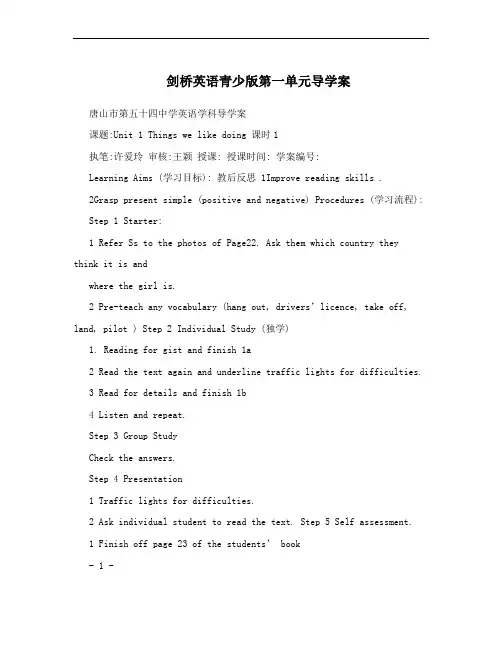
剑桥英语青少版第一单元导学案唐山市第五十四中学英语学科导学案课题:Unit 1 Things we like doing 课时1执笔:许爱玲审核:王颖授课: 授课时间: 学案编号:Learning Aims (学习目标): 教后反思 1Improve reading skills .2Grasp present simple (positive and negative) Procedures (学习流程): Step 1 Starter:1 Refer Ss to the photos of Page22. Ask them which country theythink it is andwhere the girl is.2 Pre-teach any vocabulary (hang out, drivers’licence, take off, land, pilot ) Step 2 Individual Study (独学)1. Reading for gist and finish 1a2 Read the text again and underline traffic lights for difficulties.3 Read for details and finish 1b4 Listen and repeat.Step 3 Group StudyCheck the answers.Step 4 Presentation1 Traffic lights for difficulties.2 Ask individual student to read the text. Step 5 Self assessment.1 Finish off page 23 of the students’ book- 1 -唐山市第五十四中学***学科导学案班级: 姓名: 小组: 组内编号: 课时:12 Finish the exercises.1 Jenny ____ in an office. Her parents ____in a hospital. A work works B works work C work are working D is working work2 One of the boys_____ a black hat.A haveB there isC there areD has3 We will go shopping if it____ tomorrow.A don't rainB didn't rainC doesn't rainD isn't rain 4 He said the sun ____in the east and ____in the west. A rose; set B rises; sets C rises, set D rise; sets 5 Wang Mei ____ music and often ____ to music. A like; listen B likes; listens C like; are listening D liking ; listen6 Jenny____ English every evening.A has studyB studiesC studyD stuidedStep 6 Homework1 Finish off workbook of this lesson.2 Read the text three times after class.- 2 -唐山市第五十四中学英语学科导学案课题:Unit1 Things we like doing 课时2执笔:许爱玲审核:王颖授课: 授课时间: 学案编号:Learning Aims (学习目标): 教后反思1Grasp the vocabulary of page24 and study like + doing2Develop Ss’ reading and speaking skills. Procedures (学习流程): Step 1 Starter:Play a game. (Say out a hobby or an interest that begins with 26 letters.)Step 2 Individual Study (独学)Do parts3,4,5,6 of page 24,25.Step 3 Group StudyCheck the answers.Step 4 PresentationTraffic lights for difficulties. Step 5 Self assessment.Li Mei has a new classmate from New York. His 71 is Peter. Everything here 72 new to him. He doesn’t speak Chinese, but he speaks good English. He can 73 many games, too. Miss Yang asked Li Mei to 74 him to speak Chinese. Li Mei was very 75 . She thought she could 76 English from Peter. Now she can speak 77 English and Peter can 78 some Chinese words.Now they are 79 at table and having 80 at school. Li Mei teaches him how to use- 3 -唐山市第五十四中学***学科导学案班级: 姓名: 小组: 组内编号: 课时:1 chopsticks.( )71. A. friend B. classmate C. name D. teacher( )72. A. am B. is C. are D. be( )73. A. play B. have C. like D. send( )74. A. see B. watch C. help D. tell( )75. A. sorry B. careful C. sad D. happy( )76. A. get B. borrow C. learn D. teach( )77. A. any B. some C. many D. no( )78. A. tell B. write C. say D. read( )79. A. sitting B. standing C. working D. talking( )80. A. a meeting B. a party C. lunch D. teaMrs. Black is a fifty years old woman. She lives in a beautiful house in a small town.She has two cats. One is very big and the other is quite small. She likes them verymuch. One day, Mrs. White, a friend of hers, comes to see her. When she sees twoholes in the door, a large hole and a small hole, she is very surprised and says: “ My dear friend, why are there two holes in your door?”“Let the cats come in and go out, of course.” Mrs. Black answers.“But why are there two holes? Isn’t one enough?” asks her friend.“How can the big cat go through the small hole?” Mrs. Black says.根据短文内容,判断下列句子的正(T)误(F)。

! Ⅰ: .: , . ?: ’ . , ?: , ***.: , .: , ***.: , .: ,: , .: , .: .: , .: .Ⅱ.: .: , ’.这些新朋友将要伴随我们一学期的英语课,让我们来认识新朋友(做人物的) , , .(板书): .(): ’. , .看看哪个小朋友最热情。
: , .: , , .: .( ): ’. , .: , .: 刚刚**小朋友声音非常响亮,非常热情。
, , .: , .(, ): ’.: .(操练一):记住新朋友的样子了吗?’. , .: .(操练二): . .画圈。
. ’.先把第一幅图下面的名字读一遍。
: .: ? , ’ , . , , .把这些名字读给同桌听听。
: .: .: .[](接最后一图) : .(手势,板书) .: ( ):(音标读): , . .(手势,板书) .: .: ?: .[]: (边画图边让学生猜) ? . ’. (手势,板书) .: (): (音标读)(, , ): .(操练一): . .: .(操练二): , .(让学生上台指着投影)(操练三): , . ( .)(操练四): , , . .(操练五): , . ’, .(操练六): , . .连线。
同桌先把这些单词读一读。
: .: . (指着) ? ?: . ()(操练七): 打钩。
.(读完下面的单词)谁来当当小老师,指着单词让大家跟你读呢?(, .)(操练八): . .: .: .( ): , , , , . ? ’. (,只看不说,坐好。
表扬坐得好的小朋友): .( ): . , .( ):(老师边带读边表演动作): , .Ⅲ.: .: , . ….: , , ,: ( ):: , . , ’. , ’.。

Unit 1 Meet the family课题:Meet the family教学目的:1。
学会简单的打招呼和自我介绍。
能运用所学句型进行扩展性的情景会话.2.能将自己的朋友相互介绍以及将朋友介绍给老师、爸爸妈妈。
3.培养孩子讲礼貌的好习惯。
教具准备:教师准备DVD光盘、课件.教学手段:运用电视机、DVD放映机及白板辅助教学。
重难点句型:1 Hello!My name is ..。
2 This is …3 Is this your/my pen?Yes,it is。
/No,It isn’t。
4 Whose is this pen?It is/It's my/your pen.教学过程:1。
Greeting 打招呼导入新课。
2.Presentation播放光盘,让学生视听对话并试回答:What’s the name of William' s daughter?学生回答正确的话给予鼓励,回答错误的话再次播放对话内容,让学生回答。
根据图画逐一讲解并认读短对话,学习新单词。
然后大声读对话,先整体跟读,再分组跟读。
分角色进行对话练习。
3。
布置作业。
教学反思:1 课前应做好准备工作,不然上课途中少了教具总是要出教室去拿,比较耽误时间和进度。
2 教学方式应丰富些,让孩子反复跟读的记忆效果不是很佳。
Unit 2 What is it?课题:What is it?教学目的:1。
学会问答"What is it/this/that? It's.。
”。
2。
掌握出几种物品几种颜色,学会怎么描述物品。
教具准备:教师准备DVD光盘、卡片、课件。
教学手段:运用电视机、DVD放映机及白板辅助教学。
重难点句型:1 What is this / that ?This is/That is/It is a hat/an umbrella。
2 It is a red umbrella。
3 Whose is it?It’s Robert’s.4 What color is it? It’s green.教学过程:1.Warm-Up 师生打招呼,回顾上节课内容,检查并帮助学生修正作业。
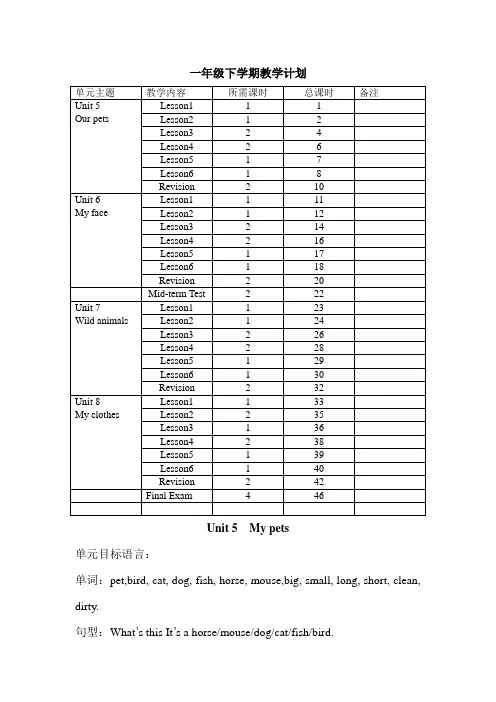
一年级下学期教学计划Unit 5 My pets单元目标语言:单词:pet,bird, cat, dog, fish, horse, mouse,big, small, long, short, clean, dirty.句型:What’s this It’s a horse/mouse/dog/cat/fish/bird.单元技能目标:听:能够听懂关于宠物的对话,描述宠物的形容词和句子,礼貌用语,辨别/p/的发音;说:能够就宠物的话题进行简单问答,说一首关于宠物描述的歌谣,能唱一首关于宠物的歌曲;读:能读出宠物的名称;写:能正确涂色,能写出数字,能圈出所要选择的项目;第一课时Lesson 1教学目标:1、能看图片说出六种动物,并记住他们的分类-pet;2、能听懂关于pet show的对话内容;重点语言:?Cat, dog, fish, horse, mouse, bird , pet show教学材料:宠物单词卡片,CD,颜色单词卡片教学步骤:1、Greeting and roll call.2、展示颜色单词卡片,说:Where’s grey等,学生指着相应的卡片说:Here!复习颜色;3、出示宠物单词卡片,例cat, 用肢体语言和声音来描述单词,请学生跟做,认读、指认、做动作(发声音)配对;用同样的方式出示其他动物的图片和单词。
4、分组跟读,每组代表一种动物,跟读时大声读出并站起来;男女生分组拍卡片,老师说,学生拍出相应的图片;5、请学生翻看第1部分,回答问题:what can you see Who can yousee 播放CD, 请学生仔细听,教师释义show, lovely 并解释整个对话的意思,听第二遍,指认听到的宠物;6、听第2部分CD,指认并跟读;7、结束本课;作业:第1部分听两遍,理解意思,第二部分听、指认并跟读;请家长听写单词,学生在作业单上画出宠物。
第二课时Lesson 2教学目标:1、复习宠物、形容词和颜色;2、会说一首关于描述宠物的歌谣;重点语言:6个宠物,形容词:beautiful, ugly, young, happy,教学材料:宠物单词卡片教学步骤:1、Warm up:1)和全体同学打招呼,再和个别学生打招呼;2)点名(Roll call).3) Hi, Hello song.2、复习宠物:(1)将宠物卡片放在黑板上,教师用纸片遮住大部分,露出一角,请学生说出宠物名称,并提问:Is the ____ young/old/beautiful/ugly/happy/sad(2)将宠物卡片摆放在黑板上,请学生闭眼,教师拿走一张,让学生猜出which one is missing The ____ is missing.3、请学生翻看第3部分图片,分享各个宠物的特点; 教师播放CD,听chant, 播放第二遍跟读;第三遍和老师读;第四遍男女生分组读;第五遍教师一组,其余每列一组扮演各种动物,一起来说;4、请学生单个展示;5、听第4部分,Listen and say the number.6、结束本课作业:会说chant.听第4部分,并说出对应的数字。

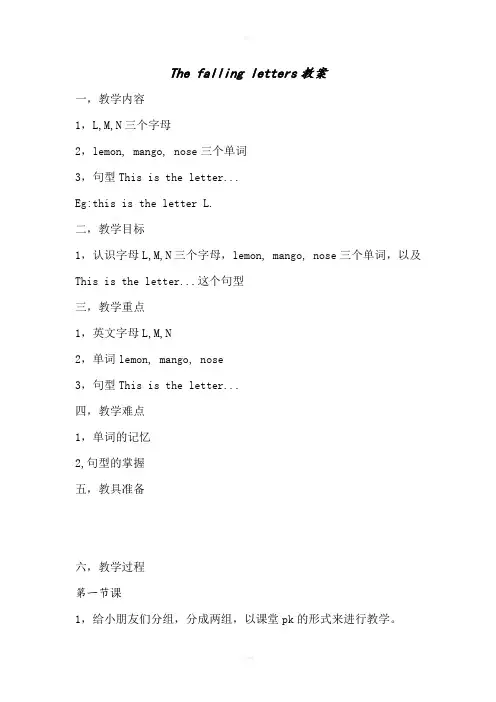
The falling letters教案一,教学内容1,L,M,N三个字母2,lemon, mango, nose三个单词3,句型This is the letter...Eg:this is the letter L.二,教学目标1,认识字母L,M,N三个字母,lemon, mango, nose三个单词,以及This is the letter...这个句型三,教学重点1,英文字母L,M,N2,单词lemon, mango, nose3,句型This is the letter...四,教学难点1,单词的记忆2,句型的掌握五,教具准备六,教学过程第一节课1,给小朋友们分组,分成两组,以课堂pk的形式来进行教学。
2,课堂第一步,进行踩地雷游戏,准备好之前学习过的英文字母,同时把这节课要学习的L,M,N三个字母也掺杂进去。
让两组小朋友们来比赛,首先每个组按顺序派出代表。
然后两组的代表就比赛谁能快速的踩到那个字母,并且大声读出,而且不准踩到装有地雷的卡片。
如果踩到了装有地雷的卡片,全部小朋友就说,1,2,3,Bomb,并且双手作开花状。
最后,游戏结束后,因为小朋友们都不认识L,M,N三个字母,游戏过程中肯定没什么小朋友去踩这三个字母,然后就问小朋友为什么这三个字母还那么干净,为什么没人踩他们。
接着就引出今天的要学习的字母L,M,N3,课堂第二步,教学字母L,M,N。
就这三个字母来跟小朋友们玩速度抢答的游戏。
4,第三关,猜一猜,玩This is the letter...游戏,老师拿一张纸在纸上写字母。
让孩子们猜老师写了什么字母,然后跟老师说this is the letter...第二节课1,课堂第四关,总结一下上节课的游戏情况,看看哪组的小朋友得到的分数多。
然后让得分少的小朋友们上黑板画画,就画芒果,柠檬,跟鼻子。
接着引出这节课的另一个内容单词教学。
2,正式教学几个以LMN开头的英文字母,lemon, mango,nose.3,课堂第五关,找小伙伴。
青少版新概念1A教案Unit1 Meet the family!认识一下我们全家吧句型与结构词课文注释:图1:Hello! —标准的非正式问候语,用于问候初次见面的人、朋友和熟人。
My name is William Jenkins. William Jenkins在英文中,名在前,姓在后。
所有名字(专有名词)的首字母都要大写。
Is —(第三人称单数现在时)动词be的现在时第三人称单数形式。
图2:this —指示代词,用于指近处的人或物。
My wife —第一人称物主形容词+名词图3:How do you do?—正式、礼貌用语。
用于问候初次见面的人。
用how do you do来回答。
图4:Lucy’s=Lucy is切记This is不能缩写。
图5:My son, Robert.—这个陈述句中有两个补语:My son和Robert这两个名词指的是同一个人,第二个名词说明了第一个名词的一些情况。
二者是同位语。
书写时,同位的名词之间要用逗号。
your—第二人物主形容词图6:Nice to meet you!—固定短语,用于非正式的介绍,用于回答Hi!其它:whose —疑问代词no 与not的区别(稍微提一提,让学生以后读句子有方向性地培养语感)以下只是备注,不详讲。
not副词。
用在be动词,情态动词,助动词之后。
Is not/can not/do notnot可位于动名词、现在分词和不定式符号to之前,构成其否定形式。
Not doing/not done/not tonot可以与every,both,all等词连用,意为“并非,不都是”,表示部分否定Not every/not both/not allno用作副词1、no置于可数名词单数前面时,相当于not a;放在可数名词复数前面或不可数名词前时,相当于not any,意为“没有的,全无的”、“远非的、完全不是的”。
2、no用于命令或标牌中,意为“禁止的”。
《剑桥国际少儿英语》第一册教案
Unit 4 My Family
单元目标语言:语词family, mother, father, brother, sister, grandmother, grandfather, box, old, young, happy, sad, beautiful, ugly, Bertie Bat
结构Who ’s that? We ’re (young).
单元技能目标: 听 能够听懂问候的常用语,教师和课本上的指令语,家庭成员的名称和所表达的关系,形容词,辨别/b/的发音 说 能够就家庭成员的话题进行简单回答,用形容词描述人物,能唱一首关于家庭成员和形容词的歌曲 读 能认读出阿拉伯数字
写 能正确涂色,能写出数字,能圈出所要选择的项目
第一课时 Lesson 1
课堂教学过程 (40 mins )
第二课时Lesson 2
课堂教学过程(40 mins)
第三课时Lesson 3
课堂教学过程(40 mins)
第四课时Lesson 4
课堂教学过程(40 mins)
第五课时Lesson 5
课堂教学过程(40 mins)
第六课时Lesson 6
课堂教学过程(40 mins)。
本期总第课时Step2 Presentation (10mins)1.Listen and stick (PPT4)T: I like your voice. Now, it’s time to stick your paster. Are you ready?S: Yes!T: OK, have got the answer? The black boy is...S1: Three.T: Good! The yellow boy is...S2: Five.T: Great! How old is the baby? Please try to usea whole sentence to answer my question.S3: She is one.T: Yes, you are so clever! How old is the boy onthe bench?S4: He is two.T: Wonderful! How old is the girl with an ice cream? S5: She is six.T: Good! How old is the pink girl?S6: She is four.T: Well down!2.Talk to Maskman (PPT5)T: Do you like Maskman?Ss: Yes!T: Do you want to talk with him?Ss:Yes!T: OK, now listen carefully and then I will invite some students to talk to Maskman.Step3 Practice (18mins)1.Look and draw lines (PPT6)T: Now, please open your activity book and turn to page4.Try to find the rules and draw lines.2.Listen, draw lines and say (PPT7)T: Look at the shadow and picture. Who are they? Match the shadow and picture.3.Look and circle. Say the number (PPT8)T: Look at the chart and circle the different number. Please tell me in the first/second/last chart which number is different?Ss: Two/three/one.4.Listen, circle and color (PPT9)T: Listen to the tape. First, circle the number whatyou heard. Second, color the circle in the box.5.Listen and circle (PPT10)T: Circle the number you heard.6.Listen and draw (PPT11)T: Listen to the tape and draw candles on the cake.If you heard four and you should draw four candles, got it?Step4 Production (6mins)1.Listen and circle (PPT12)T: Listen to the tape and circle the number.2.Count and draw. Say the number (PPT13)T: How many Marie are there?Ss: Five.T: So, how many grids should we draw?Ss: Five.3.Trace and say (PPT14)Step5 Homework (1min)1.Review the words: one, two, three, four, five, six.municate with your friends by the sentences: What’s your name/How old are you?。
Unit1 My name’s Gina.Section A 1a-2d参考答案课前预习1、试着写出下列单词的完全形式(1) I am (2) name is (3) what is (4) is not (5) it is (6) are not2、你能将下列句子译成英语吗?(1)my book (2)your bike (3) his schoolbag (4)her pen (5)its name (6)nice (7)meet (8)you (9)what3、译一译What’s your name? / My name is Jenny. / I am Gina. Nice to meet you! / Hi, Mary! I am Jim.合作探究2.Nice to meet you. / Nice to meet you, too.5. What’s her name? / What’s his name? / What’s its name?6. 问候他人:Hello!/Hi! Nice to meet you. Nice to meet you, too.介绍自己:My name is … I am…询问对方姓名和回答:What’s your name? My name is …/I am…询问他人姓名和回答:What’s her name? What’s his name? What’s its name?Her/His/Its name is …/ She/He/It is…随堂速练1、单项选择。
CB2、用am,is,are 填空。
is ; is ; am ; is ; is ; Are ; is ; are3、句型转换。
1)What’s his 2)My name is Mary. 3)Nice to meet you, too.。
` Module 1 Here and nowUnit 1 Things we like doing The 1st periodReading: An unusual hobby教学目标:知识目标:1. To enable students to know the following wordsnormal, unusual, take off, land, tell sb. how to do, learn to do, love /like/hate/enjoy doing sth.2. To enable students to know that when we talk about daily life, we use present simple tense. 能力目标:To enable students to learn the reading strategy to find the main idea of each paragraph and read for details.To retell a typical day in the order of time with the words given and the present simple tense. 情感目标:To enable students to know the hobby culture and the importance of hobbies in life教学重点:V ocabulary for a typical day at a helicopter flying schoolTo enable students to learn the reading strategy to find the main idea of each paragraph and read for details.To retell a typical day in the order of time with the words given and the present simple tense. 教学难点:To retell a typical day in the order of time with the words above and the present simple tense.教学过程:教学目的Step 1 Lead-in(pre-reading)1aLook at the picture of Julie Baker.Where do you think she comes from?What's her hobby?Read the text quickly to check your ideas.She is Australian and she has an unusual hobby:flying helicopters.Step 2 While-reading (Fast reading)How many parts are there in the passage?What's the main idea of each part?Part 1: A short introduction of Julie BakerPart 2: Julie's typical Sunday as a student at the Helicopter Flying School near BrisbaneStep 3.While-reading (careful reading)Read Part 1: A short introduction of Julie Baker.Read Part 1: A short introduction of Julie Baker. Answer questions in1b 引出话题,和相关词汇分段,了解文章结构,总结段意细读,找信息,学习相关词汇,1.How old is Julie?2. What “normal” activities does she like?While-reading (careful reading)Read the Part 2 and answer the questions.3. What does she learn on Sundays from 8.00 to 10.45?4. What doesn’t Julie like very much?5. What does Julie want to be in the future?Step 4 While-reading (deep reading):1. Flying helicopters is an unusual hobby for us. Is it an unusual hobby in Australia? Why?No.Australia is the world's largest island. The quickest way of travelling around it is by plane. Helicopter flying schools can be found all over Australia and it is through schools like these that people learn to pilot helicopters and other aircraft. There are a lot of jobs in flying industry.2.Is it easy to keep this hobby? Give reasons from the text.No.She needs to get up early on Sunday morning, and she doesn't like classroom work.Her parents have to drive her to the helicopter and drive her home. They get nervous.3.Why can Julie keep her hobby?Because she enjoys looking down at the Sunshine Coast while flying. The most important is she loves flying and she wants to be a pilot.It's her dream.Step 5.Post-reading (vocabulary)Read after mp3, underline the verb phrases about the typical day at the helicopter flying school and the vocabulary about likes and dislikes.Step 6 Discussion:What’s your hobby? Is it easy to keep it? Why?Step 7 Summary:1 expression of likes and dislikeslike/love/hate/enjoy doing 了解中澳爱好文化差异思考坚持一个爱好的不易爱好和梦想的联系借助表格和重点词汇支撑,复述文章,巩固词汇的应用。
课题:Unit 1 Things we like doing课时1执笔:许爱玲审核:王颖授课:授课时间:学案编号:Learning Aims (学习目标):1Improve reading skills .2Grasp present simple (positive and negative)Procedures (学习流程):Step 1 Starter:1 Refer Ss to the photos of Page22. Ask them which country they think it is and where the girl is.2 Pre-teach any vocabulary (hang out, drivers’licence, take off, land, pilot ) Step 2 Individual Study (独学)1. Reading for gist and finish 1a2 Read the text again and underline traffic lights for difficulties.3 Read for details and finish 1b4 Listen and repeat.Step 3 Group StudyCheck the answers.Step 4Presentation1 Traffic lights for difficulties.2 Ask individual student to read the text.Step 5 Self assessment.1 Finish off page 23 of the students’ book- 1 -2 Finish the exercises.1 Jenny ____ in an office. Her parents ____in a hospital.A work worksB works workC work are workingD is working work2 One of the boys_____ a black hat.A haveB there isC there areD has3 We will go shopping if it____ tomorrow.A don't rainB didn't rainC doesn't rainD isn't rain4 He said the sun ____in the east and ____in the west.A rose; setB rises; setsC rises, setD rise; sets5 Wang Mei ____ music and often ____ to music.A like; listenB likes; listensC like; are listeningD liking ;listen6 Jenny____ English every evening.A has studyB studiesC studyD stuidedStep 6 Homework1 Finish off workbook of this lesson.2 Read the text three times after class.- 2 -课题:Unit1 Things we like doing 课时2执笔:许爱玲审核:王颖授课:授课时间:学案编号:Learning Aims (学习目标):1Grasp the vocabulary of page24 and study like + doing2Develop Ss’ reading and speaking skills.Procedures (学习流程):Step 1 Starter:Play a game. (Say out a hobby or an interest that begins with 26 letters.)Step 2 Individual Study (独学)Do parts3,4,5,6 of page 24,25.Step 3 Group StudyCheck the answers.Step 4PresentationTraffic lights for difficulties.Step 5 Self assessment.Li Mei has a new classmate from New York. His 71 is Peter. Everything here 72 new to him. He doesn’t speak Chinese, but he spea ks good English. He can 73 many games, too. Miss Yang asked Li Mei to 74 him to speak Chinese. Li Mei was very 75 . She thought she could 76 English from Peter. Now she can speak 77 English and Peter can 78 some Chinese words.Now they are 79 at table and having 80 at school. Li Mei teaches him how to use - 3 -chopsticks.( )71. A. friend B. classmate C. name D. teacher( )72. A. am B. is C. are D. be( )73. A. play B. have C. like D. send( )74. A. see B. watch C. help D. tell( )75. A. sorry B. careful C. sad D. happy( )76. A. get B. borrow C. learn D. teach( )77. A. any B. some C. many D. no( )78. A. tell B. write C. say D. read( )79. A. sitting B. standing C. working D. talking( )80. A. a meeting B. a party C. lunch D. teaMrs. Black is a fifty years old woman. She lives in a beautiful house in a small town. She has two cats. One is very big and the other is quite small. She likes them very much. One day, Mrs. White, a friend of hers, comes to see her. When she sees two holes in the door, a large hole and a small hole, she is very surprised and says: “ My dear friend, why are there two holes in your door?”“Let the cats come in and go out, of course.” Mrs. Black answers.“But why are there two holes? Isn’t one enough?” asks her friend.“How can the big cat go through the small hole?” Mrs. Black says.根据短文内容,判断下列句子的正(T)误(F)。
( ) 81. Mrs. Black lives in a tall building.( ) 82. Mrs. Black has two cats. One is old and the other is young.( ) 83. Mrs. White thinks one big hole in the door is enough.( ) 84. Mrs. White loves her cats very much.( ) 85. Mrs. Black thinks big cat goes through the big hole and the small cat goes through the small hole.Step 6 Homework- 4 -课题:Unit 1 Things we like doing课时3执笔:许爱玲审核:王颖授课:授课时间:学案编号:Learning Aims (学习目标):1Improve reading and writing skills .2Grasp everyday English:guy, what about him? That’s weird! Shut up! So what?Step 1 Starter:IGuess the following expresses’ meaning and match them.1 guy a Be quiet!2 What about him? b I don’t think it’s important.3That’s weird! c teenage boy or man4 Shut up ! d very strange5 So what? e What do you want to say about him? II Fill in the spaces with these expresses.(page27 9a)Step 2 Individual Study (独学)1. Reading for gist and finish 1a2 Read the text again and underline traffic lights for difficulties.3 Read for details and finish 1b4 Listen and repeat.Step 3 Group StudyCheck the answers.Step 4Presentation- 5 -1 Traffic lights for difficulties.2 Act out the photo story.Step 5 Self assessment.( Do part10 of page 27)1 Explain to Ss that they are going to read a letter from a new penfriend. Before they answer the letters, they answer the letter, they must read it quickly and answer the question.(Do part10a)2 Write a letter in reply to Lisa.(Do part10b)Step 6 Homework1 Finish off workbook of this lesson.2 Read the story three times after class.- 6 -。